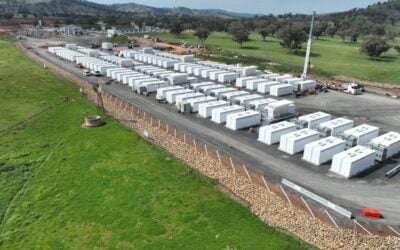
After a recent tender process, up to 1,300MWh of grid-connected energy storage will be deployed in combination with renewable energy in South Africa through a number of large-scale projects.
The country’s Ministry of Mineral Resources and Energy has conducted a tender through its ‘Risk Mitigation Independent Power Producer Programme’ (RMIPP) for up to 2GW of energy capacity, needed to bridge the gap between demand and supply. Independent power producers took part to get 20-year power purchase agreements (PPAs) for energy facilities that can dispatch power to the grid as required by system operator ESKOM between the hours of 5am and 9:30pm each day.
Having spotted an urgent need for these resources in the national Integrated Resource Plan of 2019, the tender was quickly launched last year and the winning preferred bidders were announced on 18 March by Minister Gwede Mantashe. The resources have to be up and running by the middle of 2022. Mantashe said that the intention is to not only reduce electricity supply constraints but also to reduce “extensive utilisation” of peaking generators burning diesel fuel over medium to long-term timescales.
Also announced by Mantashe last week was the launch of the fifth window of the country’s Renewable Energy IPP Procurement Programme (REIPPPP) tender: alongside the urgent need for those 2GW of dispatchable resources, around 11,813MW of capacity from various energy sources is being sought through President Cyril Ramaphosa’s economic recovery plans after COVID-19 and last week’s launch included a tender for 1GW of solar energy.
Try Premium for just $1
- Full premium access for the first month at only $1
- Converts to an annual rate after 30 days unless cancelled
- Cancel anytime during the trial period
Premium Benefits
- Expert industry analysis and interviews
- Digital access to PV Tech Power journal
- Exclusive event discounts
Or get the full Premium subscription right away
Or continue reading this article for free
In response to the Risk Mitigation tender, 28 bid responses were received adding up to around 5,117MW of capacity. Of these, 1,845MW of project capacity from eight responses have earned Preferred Bid status. They now need to show they can be “satisfactory value for money propositions,” Minister Mantashe said.
The high volume of participants and capacity “clearly demonstrates a sustained private sector interest in participating in the South African energy landscape,” Minister Mantashe said.
“The Risk Mitigation IPP Procurement Programme succeeded in attracting project proposals featuring a variety of technology combinations. The quantity and quality of the bid responses and potential megawatt of contracted capacity allowed for a competitive price evaluation,” he said.
Analyst Corentin Baschet, of Europe-based energy storage consultancy Clean Horizon, which worked with some of the Preferred Bid winners in partnership with South African renewable energy consultancy Harmattan Renewables, told Energy-Storage.news that “South Africa is facing an urgent need for additional capacity to prevent load shedding”.
Gas, specifically LNG, was the big winner of the auction, but around 428MW of renewable energy-plus-storage was also successfully picked out. Baschet said that Clean Horizon estimates that the hybrid projects will result in around 430MW / 1,300MWh of energy storage to be deployed in the country by next summer.
Renewables-plus-storage had competed against gas for dispatchable power capacity contracts in the tender, which the analyst described as technology agnostic. According to Baschet, 1MW of natural gas represents 1MW of contracted capacity, whereas the same dispatchable capacity from renewable energy and storage would represent around 3MW of renewables and 1MW of storage with duration of storage and discharge between two to five hours (dependent on solar or wind capacity).
Three bids from renewable hybrid projects using batteries came in lower than some of the LNG projects, as shown in the chart and infographic below from Clean Horizon. The weighted average price of all Preferred Bids was R1,575 (US$106.63) per MWh.

Winners with renewables-plus-storage bids included European energy majors EDF and Total and major Saudi Arabia-headquartered power project developer ACWA Power as well as G7 Renewable Energies, a developer focused on Sub-Saharan Africa renewables projects. G7 won Preferred Bid status with Oya Energy Hybrid Facility, a 128MW hybrid project that includes wind, solar and lithium-ion batteries.
“The Oya project matches and exceeds governments expectations as it is extremely competitive while still complying with all strict requirements set by the IPP office and its advisors, guaranteeing full compliance in terms of South African regulations. Value for money has played a key role in the design choices and operational philosophy and we look forward to the successful completion of the project,” Dr Kilian Hagemann, co-founder of G7 said.
“With Oya we are pushing the boundaries of what renewable energy can provide to electricity grids not only in South Africa but around the world. While in the last few years these technologies have proven to be the cheapest form of generation, some observers continue to criticise wind and solar for its lack of reliability and dependability, especially at times when the grid is under strain. Through its unique combination of co-located wind turbines and PV arrays with a large battery, Oya can provide some power on demand at a lower cost than flexible gas projects and practically without harmful CO2 or other emissions, bringing us closer to our 2050 vision of powering South Africa’s electricity grid on 100% renewables”.
Harmattan Renewables director Chanda Nxumalo pointed out that a further three projects totalling 150MW are currently still under discussion and could still be pending award. Nxumalo said that the timelines to bid being so short means that “much of the technical due diligence will occur pre-financial close,” which needs to happen before the end of July this year.
The tender required participating technologies to be proven in use at scale for more than two years and Clean Horizon and Harmattan Renewables believe therefore that each of the winning solar-plus-storage and wind-plus-storage projects will use lithium-ion batteries. Another factor is that the timeline for procurement being so short and linked to the need to procure emergency power supply precludes other — perhaps newer — energy storage technologies from being able to participate in the opportunity, Corentin Baschet said.
The Ministry of Mineral Resources and Energy said the July 2021 date by which financial close needs to be achieved is not negotiable due to the urgency of bringing the power online and the first to come online should be injecting power to the grid by August next year.
Minister Mantashe said the eight projects will bring about R45 billion into South Africa’s economy, and will use around 50% average local content during construction. Meanwhile domestic entities represent 51% of participation in the projects and about 41% black ownership. Nearly 4,000 jobs will be created during 18 months of construction and about 13,500 jobs over the 20-year lifetime of the PPAs.





